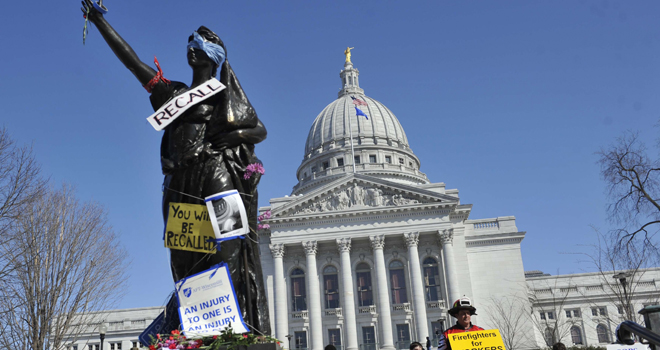Tuesday is election day in one of the Wisconsin state Senate recalls, with Democratic incumbent Dave Hansen heavily favored to defeat his Republican challenger, David VanderLeest. But this is hardly the end, with recalls on August 9 for six Republican state Senators, and on August 16 for two Democrats — with a lot of campaign spending, and get-out-the-vote operations, yet to be seen.
Republicans currently control the chamber by a majority of 19-14. Democrats hope to gain a net three seats and win a majority in a backlash against GOP Gov. Scott Walker’s anti-public employee union legislation. In other words, control of the chamber is up for grabs.
And as such, a lot of TV activity is happening — indeed, the Milwaukee Journal Sentinel reports that some insiders believe the total spending, across both sides and including independent groups, could reach $20 million when all is said and done.
Indeed, according to the Campaign Media Analysis Group, the Journal Sentinel reports, spending in the 10th District of GOP State Sen. Sheila Harsdorf has already reached three-quarters of a million dollars. So far, Democratic candidates and Dem-supporting groups have outspent the GOP side by about 2-1, though the campaign is far from over.
“We had all this drama about collective bargaining, but what is driving the advertising is fairly straightforward messaging about taxes and spending,” CMAG head Ken Goldstein, a former longtime University of Wisconsin-Madison professor, told the paper. “Democrats are criticizing Republicans for cutting education, and Republicans are criticizing Democrats for raising taxes and being fiscally irresponsible. And both are criticizing each other for any personal failing they can find.”
However, in an interview with TPM, Goldstein also cast some doubt on the contention that total spending could reach $20 million. “That number strikes me as high,” said Goldstein. “I think you’re gonna end up with not all nine of those are going to be truly competitive, especially with Republicans not able to get enough signatures for a candidate in the Hansen race.”
(Goldstein was referring to how the GOP’s original recruited candidate, state Rep. John Nygren, failed to collect 400 valid ballot petition signatures, thus not making it onto the ballot and leaving the GOP with VanderLeest.)
But beyond that, Goldstein speculated that these recalls could cause a major shift in state politics: If recalls were to flip control of the chamber, with the campaigns being fought on typical Democrat vs. Republican issues, then they could potentially become much more commonplace, limited simply to the state requirement that officials have served at least one year of their term (out of a four year term for the state Senate and the governor, and a two year term for the state Assembly) before a recall could be triggered.
“If recall becomes the norm,” said Goldstein, “we’ve shortened legislative terms to a year.”
UW-Madison Professor Charles Franklin told TPM that turnout patterns were difficult to get any handle on, but some clues could be gleaned from this past spring’s very close state Supreme Court election, where turnout of eligible voters jumped to 35 percent — which was unusually high for a spring court race — and from last week’s turnout in the Democratic primaries for the six targeted GOP-held districts.
In those primaries, the official Democratic candidates all won against fake Dem candidates, who were in fact Republican activists planted in the races by the state GOP in order to delay the general elections.
In particular, Franklin pointed to how the northwestern district of GOP Sen. Sheila Harsdorf saw its turnout for the Democratic primary nearly equal the Supreme Court race, at 90% relative turnout to the earlier race. In Harsdorf’s district, the race between Democratic candidate Shelly Moore and Isaac Weix proved to be the one seriously targeted by Republicans, but even there Moore defeated Weix by a 55%-45% margin.
“And so to see that Harsdorf’s district had almost equivalent turnout last week for the primary, almost certainly shows that the GOP ramped up its turnout hoping to beat Moore for the primary,” said Franklin. “And similarly the Democrats were also able to ramp up their turnout and hold that off.”
“It’s always iffy to go from primary to general,” added Franklin, “but you have to believe both parties were out Tuesday in the 10th. And there were other districts in the 70-plus range, but they didn’t have anywhere near as close races with the fake-Democrats vote.”









